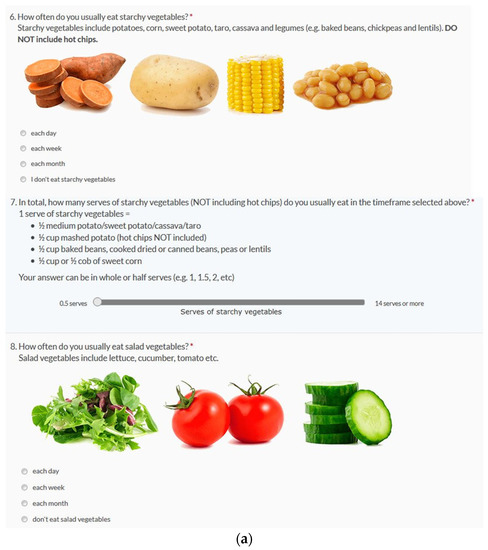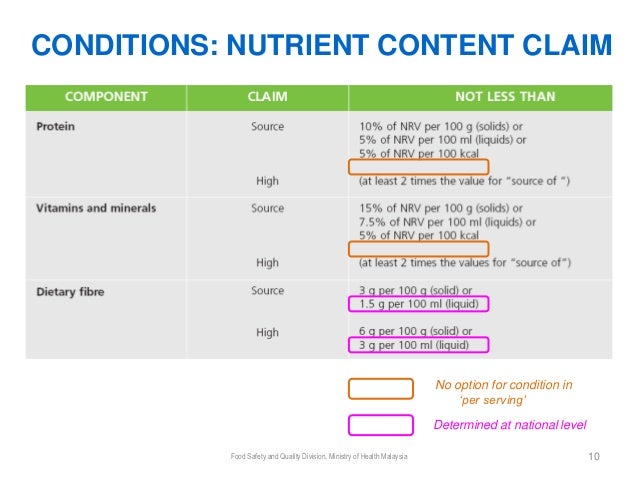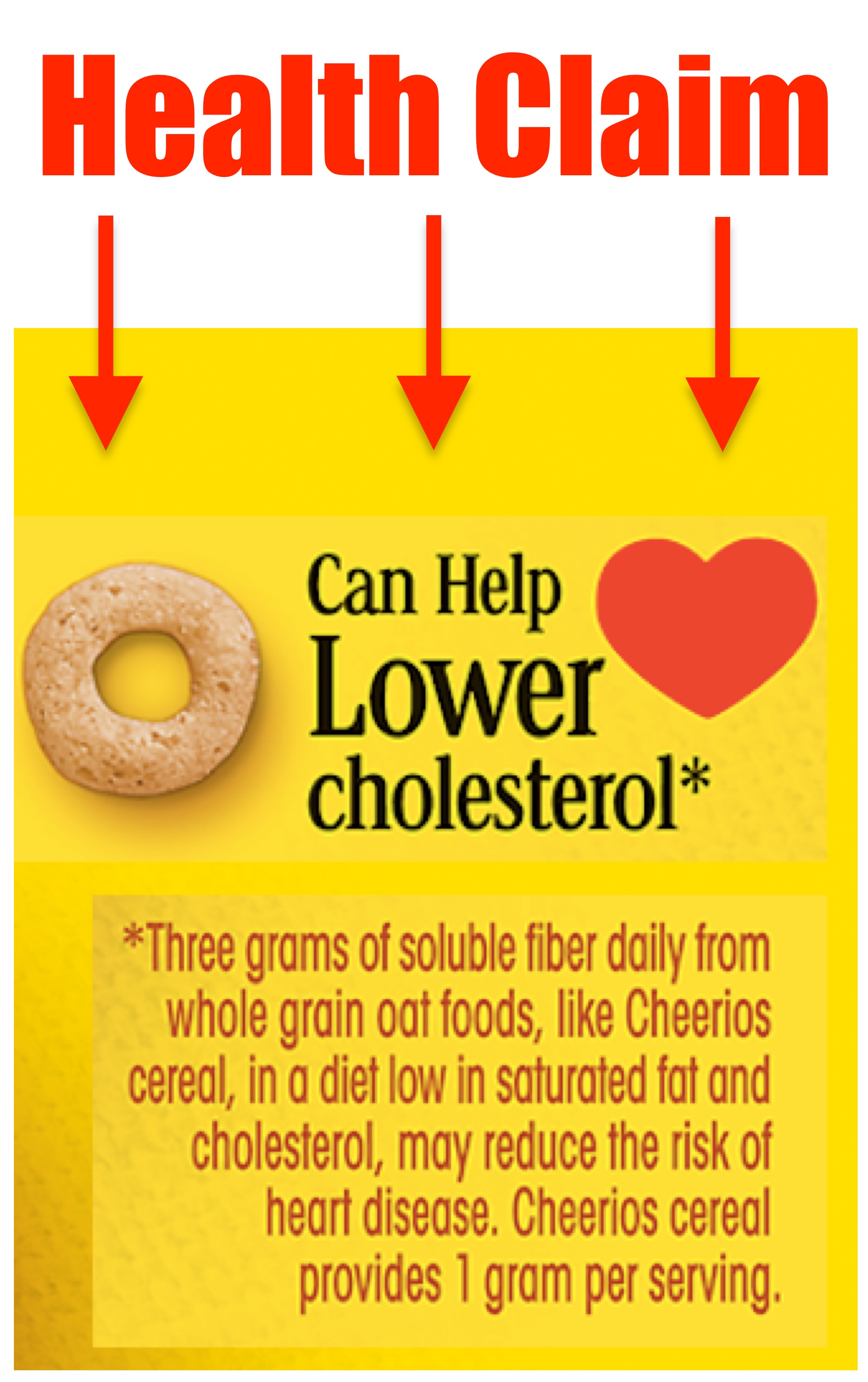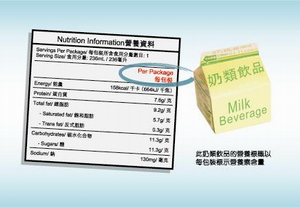41 what are nutrient claims on food labels
Nutrient Content Claims on a Food Label - LabelCalc The food product nutrition content must meet the strict guidelines and parameters set forth by the FDA in order to accurately make these nutrient content claims on a food label. For a more in-depth look at nutrient content claims, download this PDF. A Quick Reference Summary of Parameters Factual Food Labels: Health Claims - 100% Online Health Claims. In 1990, the Nutrition Labeling and Education Act allowed claims that related a specific food component (e.g., oats) to lowered disease risk (e.g., reduced cholesterol) to be printed on the label of a food product. For example, if a company wants to place a health claim on their food packaging, such as "Heart Healthy," they ...
Nutrient content claims: what they mean - Canada.ca Table of nutrient-content claims and what they mean. The food provides an amount of a nutrient that is so small it likely won't have any effect on your body. The food is processed/modified so that it contains at least 25% less of the nutrient when compared with a similar product. Contains no added fats or oils or added butter or ghee, or ...

What are nutrient claims on food labels
Understanding Food Labels | The Nutrition Source | Harvard T.H. Chan ... Nutrient content claims These statements describe the nutrients in a food beyond what is listed on the Nutrition Facts label, intended to showcase a health benefit of the food. An example is "Contains 100% Vitamin C." Food Label Claims: What You Can and Can't Trust - WebMD In the U.S., the FDA sets some common definitions for certain food claims. Specifically, the FDA regulates three types of claims. The FDA doesn't always pre-approve these claims. But manufacturers... Nutrition and health claims on labels and in food advertising The majority of nutrition claims are subject to conditions, which consist of minimum or maximum values per 100 g, 100 ml or 100 kcal of the food. For example, the claim "fat free" is only allowed ...
What are nutrient claims on food labels. Nutrient Claims on Food Labels - Truly Good Foods Jul 19, 2018 · Nutrient Claims on Food Labels - Truly Good Foods Nutrient Claims on Food Labels July 19, 2018 Nutrient claims describe the content of a food, including the amount of nutrients, calories, cholesterol or fiber, but not in exact amounts. Usually on the front of the food label, the nutrient claim provides a quick comparison between similar products. Food labelling and packaging: Nutrition, health claims and ... - GOV.UK You have to follow certain rules if you want to make a nutrition claim (for example, low fat) or a health claim (for example, calcium helps maintain normal bones). You cannot claim or imply that... Health and nutrition claims on food labels - FoodTruths Health claims on packaged foods are classified into general claims and high level health claims. A general claim will relate to the effect on health of a nutrient or ingredient in a product. An example of this type of claim would be saying that a product is a good source of protein which is 'necessary for tissue building and repair'. Nutrient Claims on Food Labels What is a Nutrient Claim? This is a claim concerning a product's nutritional value. It describes the content of a food, including the amount of nutrients, calories, cholesterol, or fiber, but not in exact amounts. Usually placed on the front of the food label, the nutrient claim provides a quick comparison between similar products.
nutrient claims on food labels chapter 2 Flashcards | Quizlet PLAY. Match. Gravity. claims on food labels. Click card to see definition 👆. Tap card to see definition 👆. marketing too directed toward health-conscious consumers. claims must comply with FDA regulations. Click again to see term 👆. Nutrient function claims - Health claims on food labels - Food labels ... For example, the nutrient function claim "Milk helps build strong bones and teeth" is unacceptable, because a nutrient function claim refers to the nutritional function of energy or a nutrient (e.g., calcium) in a food, not a particular food (e.g., milk). An acceptable claim is "Milk is an excellent source of calcium which helps build strong ... Regulating health claims on food labels using nutrient profiling: what ... Objective: Proposed Australian regulation of claims on food labels includes requirements for products carrying a health claim to meet nutrient profiling criteria. This would not apply to nutrition content claims. The present study investigated the number and healthiness of products carrying claims and the impact of the proposed regulation. Nutrition claims - European Commission A claim that a food contains a nutrient or another substance, for which specific conditions are not laid down in this Regulation, or any claim likely to have the same meaning for the consumer, may only be made where the product complies with all the applicable provisions of this Regulation, and in particular Article 5.
Nutrition content claims and health claims - Food Standards Nutrition content claims. Nutrition content claims are about the content of certain nutrients or substances in a food, such as 'low in fat ' or 'good source of calcium'. These claims need to meet certain criteria. For example, food with a 'good source of calcium' claim needs to contain at least the amount of calcium specified in the Standard. Food Packaging Claims | American Heart Association "Nutrient content claims" are used for two purposes: To describe the level of a nutrient in the product using terms such as free, high, and low or To compare the level of a nutrient in a food to another food using terms such as more, reduced, and lite. Food Label 101: What are Nutrient Claims? - Your Wellness ... If you're like my patients, you've probably been influenced to pick up a product based on the advertisement on the front. This label is called a nutrient claim ... Nutrition, health and related claims - Food Standards Standard 1.2.7 - Nutrition, health and related claims in the Food Standards Code (the Code) set out requirements for making nutrition content and health claims about food. Find out more about the Standard and the different types of claims. The Implementation Subcommittee for Food Regulation (ISFR) has guidance on how to comply with Standard 1.2.7.
Label Claims for Food & Dietary Supplements | FDA Mar 07, 2022 · Among the claims that can be used on food and dietary supplement labels are three categories of claims that are defined by statute and/or FDA regulations: health claims, nutrient content claims,...
PDF Nutrient Label Claims - Veterans Affairs Sodium Free, Salt Free, Zero Sodium, No Sodium, Without Sodium, Trivial Source of Sodium, Negligible Source of Sodium, Dietarily Insignificant Source of Sodium Less than 5 milligrams of sodium per serving. Low in Sodium, Less Sodium, Contains a Small Amount of Sodium, Low Source of Sodium 140 milligrams of sodium or less per serving.
Label Claims for Conventional Foods and Dietary Supplements the nutrition labeling and education act of 1990 (nlea) provides for the use in food labeling of health claims that characterize a relationship between a food, a food component, or dietary...
Nutrition and Health Claims in Food Labelling | Eufic This is the first piece of specific legislation to deal with nutrition and health claims. Its aims are: To ensure a high level of consumer protection by guarding against unsubstantiated, exaggerated or untruthful claims about foodstuffs. With the new legislation, consumers can rely on clear and accurate information on food labels, enabling them ...
Nutrient Claims on Food Labels – Food Smart Colorado Nutrient content claims describe a food and the level of a particular nutrient in that food. “Low fat” and “High fiber” are both examples of nutrient content claims. These types of claims usually appear on the front of a package and are regulated by the Food and Drug Administration (FDA).
Nutrition claims - Canada.ca There are two types of nutrition claims on foods: nutrient content claims and health claims. These claims must also follow certain rules from Health Canada to make sure that they are consistent and not misleading. These claims are optional and may be found on some food products. Nutrient content claims describe the amount of a nutrient in a food.
Understanding Food Labels - Nutrition: Science and Everyday Application The value printed on the Nutrition Facts panel is the percent DV, which tells you how much one serving of the food contributes towards meeting the daily requirement for that nutrient. The FDA uses the following definitions for interpreting the %DV on food labels:4. 5%DV or less means the food is low in a nutrient.

RL Food Testing Laboratory Urges Food Manufacturers to Start New Mandatory Nutrition Facts Label ...
Understanding Food Labels and Health Claims - Nutrition Essentials This label is called a Nutrition Facts panel, which gives information on the number of servings per container, the number of calories per serving, and certain nutrients. Specifically, it lists the macronutrients and four of the most important micronutrients people need to pay special attention to, such as Vitamin D, Calcium, Iron, and potassium.
Nutrient Claims Reference Chart - Helping You Choose Healthy Foods Less than 0.5 grams of fat per serving. Low fat. 3 grams or less of total fat. Low saturated fat. 1 gram or less saturated fat per serving. Saturated fat free. Less than 0.5 g of saturated fat. perserving and the amount of. trans fatty acids does not exceed 1% of the total fat.
Nutrient Claims on Food Labels Flashcards | Quizlet danaolsen2013 Nutrient Claims on Food Labels STUDY PLAY calorie free less than 5 kcal/serving low calorie 40 kcal or less per serving than the reference food reduced calorie 25% less kcal per serving than the reference food light/lite
What are Nutrient Content Claims on food labels? - Nutritionist ... The nutrient content claim is different from the information, and you can’t make claims that are in any way misleading. If a nutrient content claim remains unregulated, it does not mean you can claim that it has amazing (unsubstantiated properties). Content claims on food labels often say things like ‘high protein’ ‘low sodium’, and of course, we w...
Nutrient content claims - Canadian Food Inspection Agency Advertisements making vitamin and mineral nutrient content claims; Decision trees for nutrient content claim advertising requirements; Reference information. Foods to which vitamins, mineral nutrients and amino acids may or must be added; Nutrient content claim examples; Additional Information. Criteria for the nutrient content claim no added ...
Nutrient Content Claim vs Health Claim - LabelCalc Nutrient content claims, which are commonly used on food labels, either refer to the amount of a nutrient in a product or compare the levels of a nutrient in that food to a similar reference food. When referring to the amount of a nutrient in a product, words such as "low," "free," and "high" are often used.
Nutrition and health claims on labels and in food advertising The majority of nutrition claims are subject to conditions, which consist of minimum or maximum values per 100 g, 100 ml or 100 kcal of the food. For example, the claim "fat free" is only allowed ...
Food Label Claims: What You Can and Can't Trust - WebMD In the U.S., the FDA sets some common definitions for certain food claims. Specifically, the FDA regulates three types of claims. The FDA doesn't always pre-approve these claims. But manufacturers...







Post a Comment for "41 what are nutrient claims on food labels"